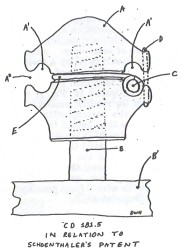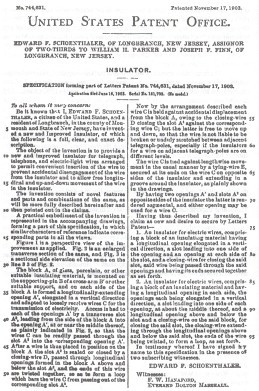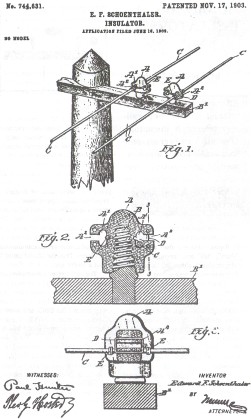The "Spaceman" Rides Again!
by Dean Hemphill, NIA #4759
Reprinted from "Crown Jewels of the Wire", July 1992, page 23
The April, 1992 issue of "Crown Jewels of the Wire" contained an
article about my unusual "spaceman" insulator. When I wrote that
article, I had virtually no information about the piece. Since then, I've
learned more about it, and I'd like to continue the story. I tend to ramble a
bit, so please bear with me.
Up until this year, I'd never been to an insulator
show. No shows were held in the Dallas / Fort Worth area. Fortunately, the D/FW
area's first show finally happened. The Metroplex Insulator Show took place in
Fort Worth, on March 7. I reserved a show display table well in advance, and
then picked out a bunch of insulators to display. The theme of my display was
glass "oddities", and the "spaceman" certainly belonged in
that category. When the big day arrived, I carefully packed the
"spaceman" and carried it to the show.
The "spaceman" was
certainly an attention-getter. It was arguably the most unusual piece on
display. I was swamped with questions from curious onlookers. As in most
hobbies, news travels fast in the insulator world. Many people at the show knew
that I had this insulator, and they'd been hoping I'd bring it to the show so
they could look it over. As usual, none of them had ever seen anything like it.
Some people thought it was a two-piece insulator until I showed them otherwise.
My pitiful show display didn't compare to the colorful displays that the others
had brought, but I had a great time, and I'll definitely make next year's show
with an improved display. I bought several insulators that were high up on my
"hit list", all at reasonable prices, and I met a lot of nice folks,
including Marilyn and Bill Albers. Marilyn plays an important part in this
story.
While talking with Marilyn during the show, I mentioned that N. R.
Woodward had wanted me to bring my insulator to him in Houston so that he could
inspect and document it. Based on my photographs and description, he had said
that he'd most likely assign the insulator a new CD number, but, of course, he'd
have to see it in person. Unfortunately, I've been too busy and too broke to
make the seven-hour-each-way journey to Houston, and I was not about to trust
the Post Office or U.P.S. with my insulator. Marilyn said that she visited Mr.
Woodward fairly often, and generously offered to carry my insulator to him. This
was an offer I couldn't refuse, so I packed up the "spaceman" and sent
it to Houston with Marilyn. I knew I could depend on her, and I was right. A
couple of days later, I got a note in the mail from Marilyn, telling me that all
was well, and that she would deliver the insulator to Mr. Woodward later that
same week.
The following Sunday morning, the telephone rang. It was Marilyn
Albers, quite excited, calling to tell me that she had taken the
"spaceman" to Mr. Woodward, and that she had some news. After looking over the insulator in
person, Mr. Woodward had assigned it CD number 181.5 (presumably because it
looks a little like the CD 181 "Pluto"). He had also found that this
piece was similar to a design patented in 1903. Needless to say, I was thrilled
to hear all of this. Marilyn was aware that I had written an article for
"Crown Jewels of the Wire", and she suggested that I contact Carol
McDougald and see if I could update the article with these new findings. I
promised to do just that, after I got home from our weekly trip to the grocery
store.
As I mentioned earlier, news travels fast in the insulator hobby. When
Cindy and I returned from shopping a couple of hours later, I found a message
from John McDougald on the answering machine. He wanted to know more about what
had happened with Mr. Woodward and my insulator. I reached Carol by telephone
and told her the news. I offered to re-write my article, which was scheduled to
go to the printer the next day, so it was too late to re-write the article.
Carol did the only thing she could under the circumstances, which was to add an
editor's note to the end of the article, and make me promise to write this
follow-up article as soon as I had all of the details!
On March 20, after
several rounds of "telephone tag", I reached N. R. Woodward. We talked
about the 1903 patent he had found which was similar to my insulator. The patent
was issued on November 17, 1903, to Edward Schoenthaler (pronounced
"Shane-taller"), of Longbranch, New Jersey. The insulator design
depicted in Schoenthaler's drawings bears a very close resemblance to my
insulator. Mr. Woodward explained that, although my insulator is similar to the
Schoenthaler design, it is definitely not the same exact insulator. Someone may
have tried to duplicate Schoenthaler's design, altering it slightly to ensure
that no patent infringement would occur, or perhaps the insulator was a
prototype of Schoenthaler's design, pre-dating the patent, and modified a little
before the patent was applied for.
It is interesting to note that Schoenthaler
did not provide a model of his insulator design when he applied for the patent,
only the diagrams. In any case, Mr. Woodward is sure that the insulator was hand
pressed because it is so crudely made. He also believes that the glass was not
cast by any of the major glass manufacturers (Brookfield, Hemingray, etc.),
because by that time they were using automated insulator presses. Mr. Woodward
made the wild guess that the insulator may have been manufactured at the old
Novelty Glass Company works in Elmer, New Jersey. That's possible. Elmer is only
a few miles from Mullica Hill, where I located the insulator. Before we ended
our telephone conversation, Mr. Woodward promised to mail me a copy of the
Schoenthaler patent, which I received about two weeks later.
As I studied the
diagrams which accompanied the patent, I had the feeling that I'd seen them
before. Sure enough... the drawings appear on page 72 of the McDougalds' book (Vol.
II), the same page as the Brookfield CD 139 "Combination Safety".
It appears that my CD 181. 5 may be a distant cousin of the CD 139. I made a
Xerox copy of the side-view photograph of my insulator, grabbed a pencil, and
drew in the features shown in Schoenthaler's patent drawings. It does indeed appear that my insulator is either a prototype of the Schoenthaler design, or
a very close copy of it. The only difference is that my insulator lacks the
holes in the "arms" through which the loop-wire would have been fed.
Instead, each "arm" of my insulator has a "lip" around which
the loop-wire could have been wrapped. Marilyn Albers verified the existence of
these "lips" when she made her shadow drawings of the piece. The
groove for the tie-wire and slot for the line-wire are identical to those shown
in the patent drawings.
The funny thing about this whole deal is that knowing
all of this information seems to raise as many questions as it answers. Isn't
that always the case? Does anyone have any information on Edward F. Schoenthaler
or his 1903 patent? Did anyone ever attempt to market Schoenthaler's insulator
design? Did he ever actually make one of the insulators depicted in the patent
(remember, no model was submitted with the patent application)? Did Schoenthaler
patent any other insulator designs, or related items? Any information anyone
comes up with, even speculation, would be greatly appreciated. So far, the only
information I have is speculation, so more of the same wouldn't hurt. If enough
new info turns up, I'll write another follow-up article and share the new
information with everyone.
Another big question remains... what happened to the
other specimen of this insulator, the one I didn't buy because it was so badly
broken? Did it end up in the Gloucester County land-fill because I was too dumb
to take it for free when the nice lady offered it to me? What a depressing
thought!
This whole experience has been a lot of fun. I thoroughly enjoyed my
telephone conversations with N.R. Woodward. He is a fascinating man with a head
full of wonderful knowledge. I could listen to him talk about insulators for
hours. If you ever have the opportunity to chat with him, I promise you'll enjoy
it. I owe a debt of gratitude to Marilyn Albers for transporting my insulator to
Houston for me, and bringing it back to the Metroplex when everyone was done
with it. Marilyn also took it to the Lone Star Insulator Club's big show in
Houston on April 4th, and she tells me it was as big a hit there as it was in
Fort Worth. Last, but certainly not least, I must thank our editor, Carol
McDougald, for allowing me to bring you my story, and for doing such a super job
publishing "Crown Jewels of the Wire".

One parting thought. Just when
it seems that all has been discovered, someone comes up with something new and
exciting. It happened to me. It could happen to you. Keep searching... you never
know what you might find in some dusty old attic or lying by some long-abandoned
rail line. Good collecting to you all!

Medium Image (191 Kb)
Large Image (424 Kb)

Medium Image (108 Kb)
Large Image (243 Kb)
|
